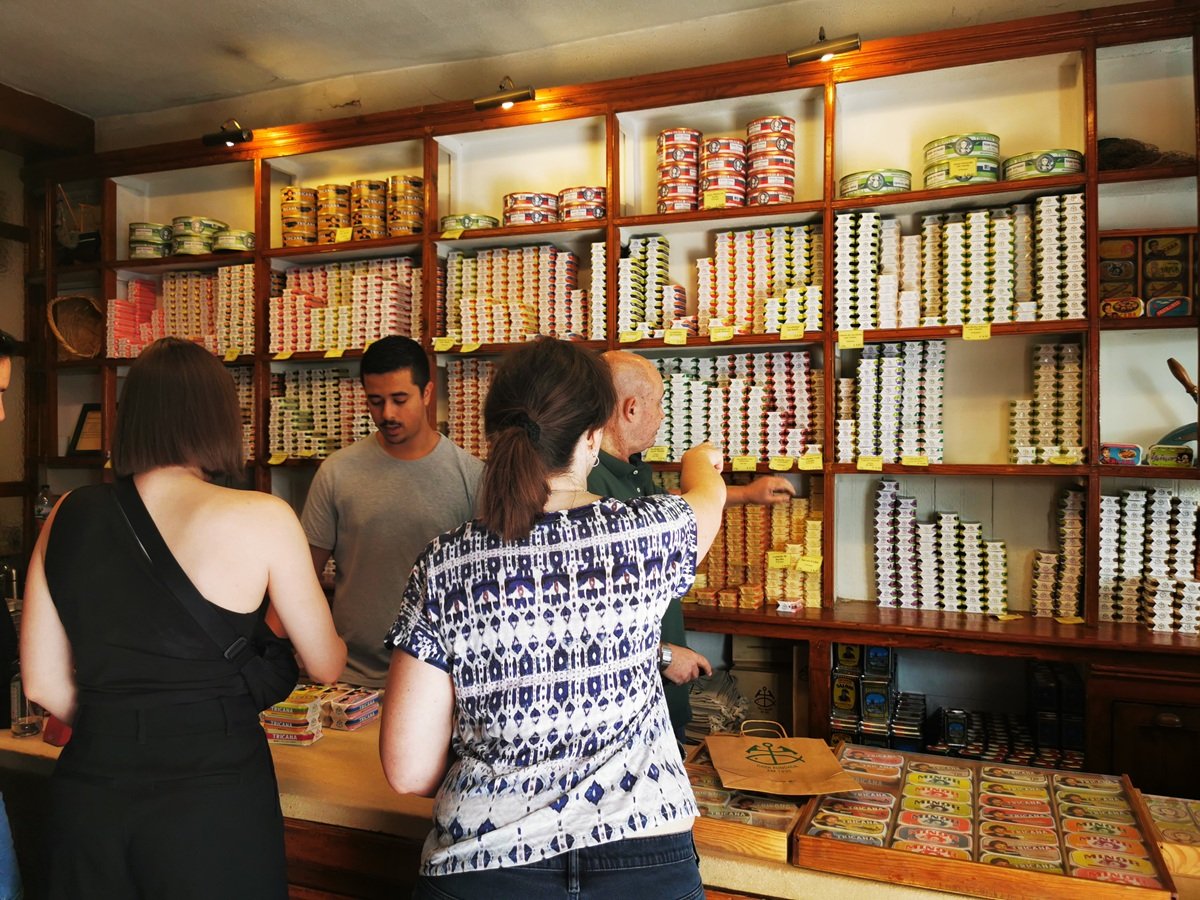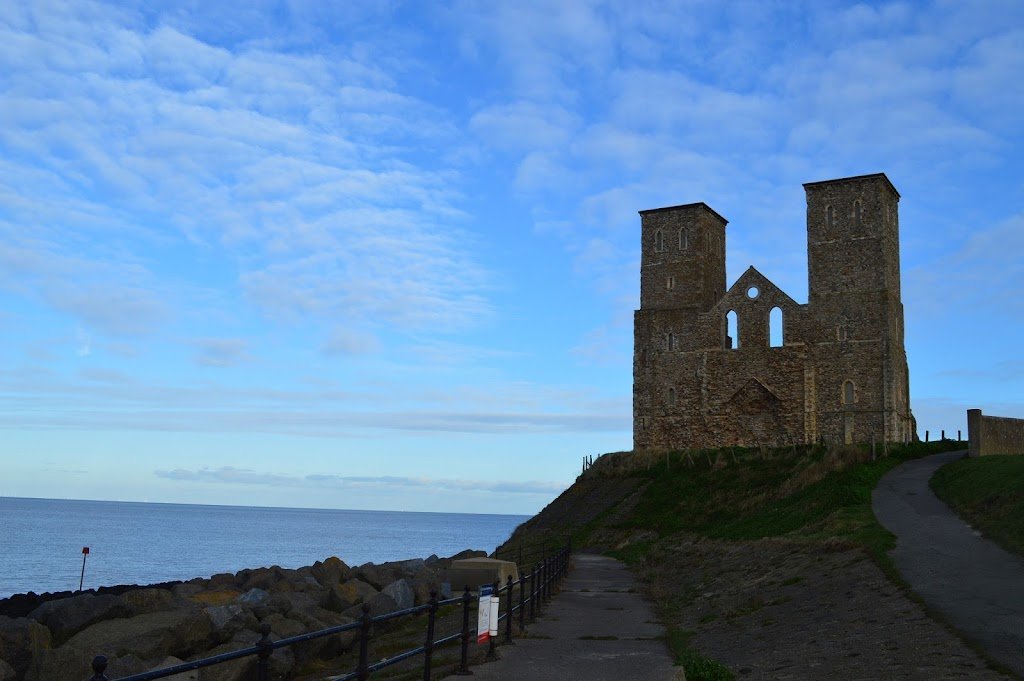I didn’t know a lot about Portuguese cuisine before my trip. That only adds to the fun. So here are a few dishes that you should definitely seek out when in Portugal.
Pasteis de Nata
I am not a fan of custard tarts at all. There is something about the cold, often lumpy texture that I find off-putting. And so when I learned that one Portuguese favourite is the pastel de nata, I’ll be the first to admit that I cringed at the idea of trying one. But believing in giving anything a try, especially while travelling, we dutifully joined the line at Pasteis de Belem on our first day. With our tarts in hand, we found a bench at a nearby park, sprinkled the enclosed pack of cinnamon on top, and dove in. These are not the custard tarts I grew up loathing. These are much smaller, barely two bites, often served warm, and they are so deliciously creamy.
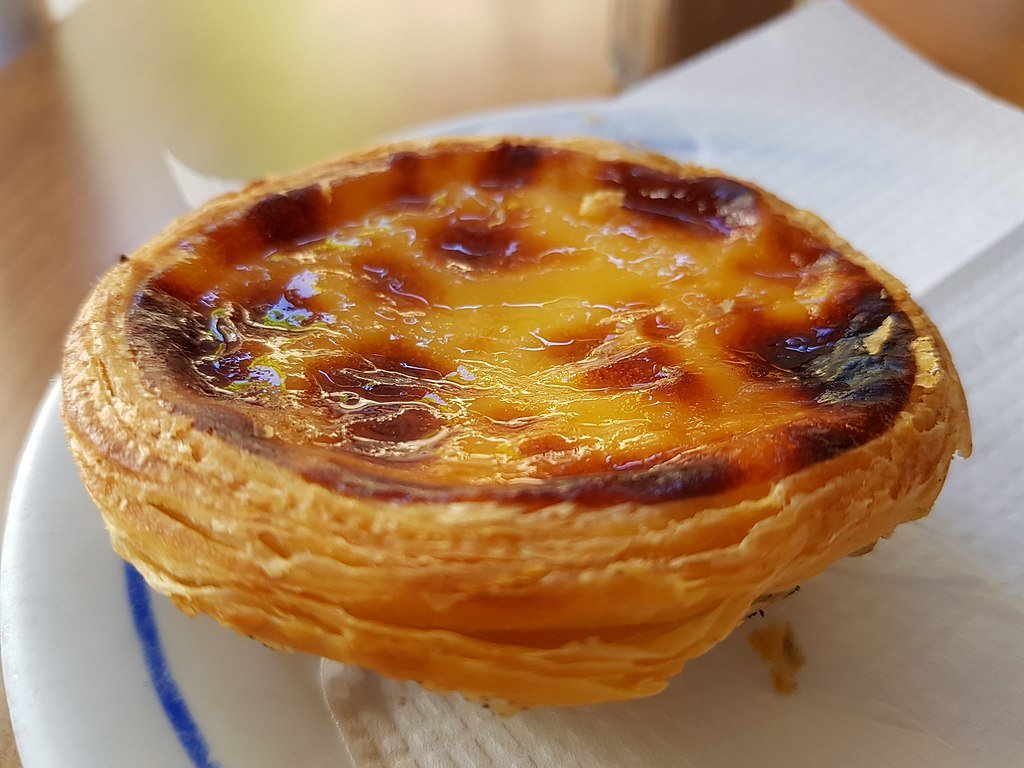
The original (and official) tarts have been produced at Pasteis de Belem since 1837. They reportedly are made according to an old secret recipe used by the monks at the nearby monastery. The bakery produces and sells an estimated 20,000 of the little tarts each day.
Now, if you don’t want to wait in line there, you can buy pasteis de nata (the generic tarts) at a number of locations throughout Lisbon. And this is where I am about to commit perhaps an unforgiveable sin. The pasteis de Belem were delicious. Absolutely wonderful. But dare I say that I enjoyed the ones we bought at the little kiosk at Lisbon Art Stay Aparthotel even more! We visited several times, enjoying the tarts, wine, and possibly the best ham sandwich I’ve ever had. Looking at the website afterwards, it’s also got some downright funky rooms so it’s going on the must-stay list next time I’m in town.
Back to the tarts… wherever you get them, enjoy them while still warm with a sprinkling of icing sugar and cinnamon.
Ginjinha
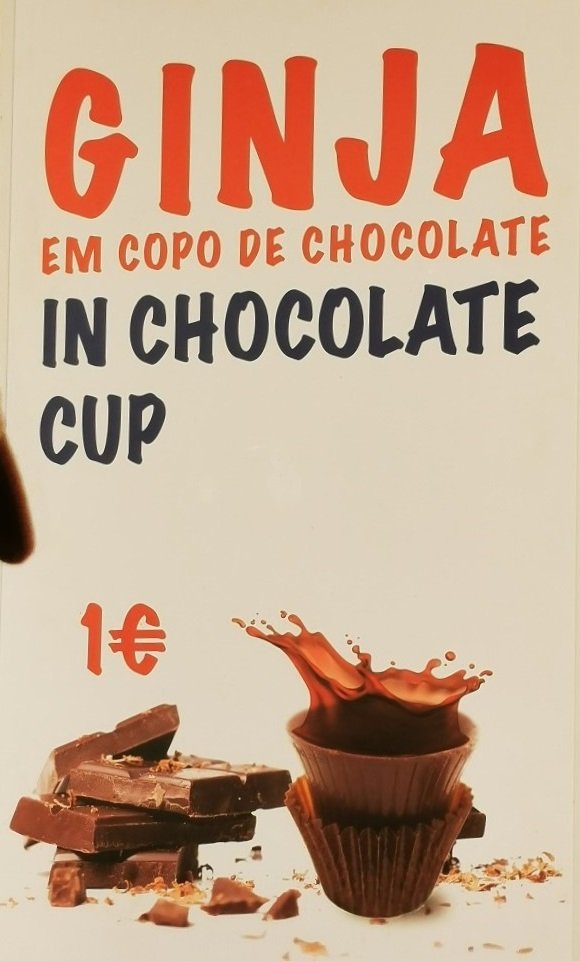
I first learned about ginjinha (or ginja) on the Travel Man show when host Richard Ayouade visited Lisbon and had some of this early one morning. I was keen to try it and had my first taste in Sintra where a little street kiosk sold it in chocolate cups. It was delicious!
Ginjinha is a Portuguese liqueur made from sour cherries (ginja). The fruit is infused in brandy or other alcohol with sugar and cinnamon. It is enjoyed in small cups, barely the size of a shot glass, which may or may not be edible.
Now I enjoy cherry brandy but the flavor can sometimes have a harshness to it. Ginja, on the other hand, has none of that. It has a rich cherry flavor with a wonderful warmth and sweetness.
It is particularly popular in and around Lisbon, and makes a great souvenir. We brought several bottles back, for us and for friends.
One important note though: just because it comes in a little shot glass does not mean you drink it like a shot. Ginja is meant to be sipped and enjoyed. Give it a try!
Fish and Seafood
You can’t go to Portugal and not enjoy the seafood. Well, I suppose you could, but why would you? Traveling from landlocked Kentucky, I was delighted by the vast array of fresh fish and seafood options everywhere I turned. Two particular specialties are sardines and bacalhau (dried, salted cod). You will find them on just about every menu. But you will also find plenty of other choices as was evident in our seafood feast in Cascais.
We’ve already talked about the importance of cod to Portuguese culture and history but it’s importance to local cuisine really can’t be ignored. It’s incredibly versatile. Don’t forget to try Bacalhau à Brás, the national dish consisting of shredded cod mixed with onions, potatoes, eggs, and olives in a sort of hash. Cod is also the centerpiece of the traditional Portuguese Christmas dinner table.
But let’s get to the real fascination: canned fish. It is everywhere, and with good reason. Canning fish was an easy way to preserve it but the Portuguese have it down to a fine art. In Lisbon you’ll find several Portuguese Sardine stores. These are definitely designed with the tourist in mind. Row upon row of brightly colored novelty cans of sardines presented in a circus-type atmosphere. It’s the ideal spot for gift buying.
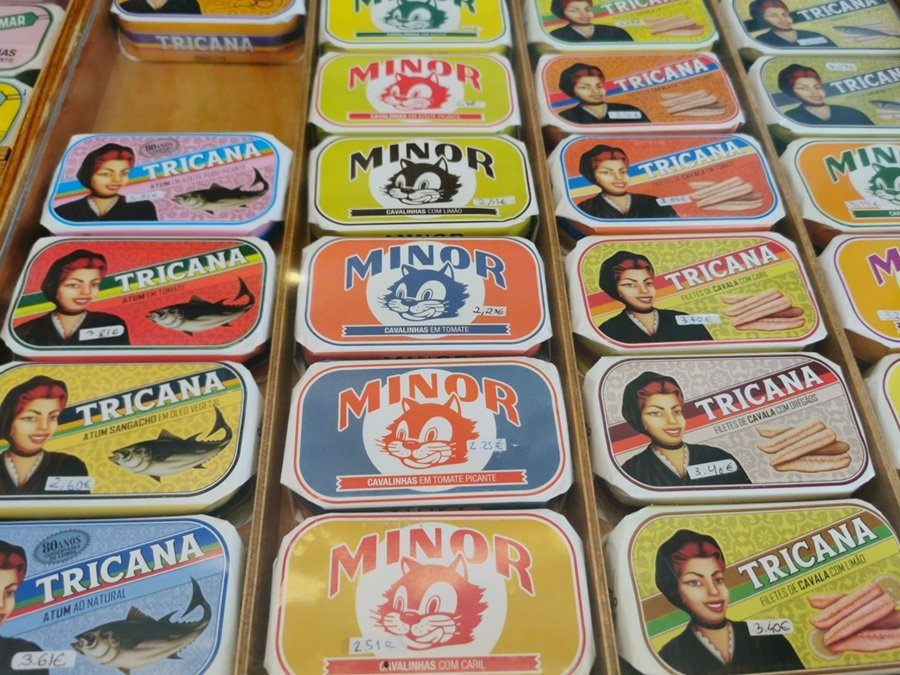
For something a little more traditional, I visited the Conservaria de Lisboa. This tiny little store has been keeping Lisbon locals supplied with canned fish since 1930. I spoke with Hemrique to learn about its history. The store is still a family business and started out as a general grocery store. During the war, canned fish became all the more important to the national diet and so the store began to specialize. That is now all it sells. The original cash register (which was bought pre-owned when the store first opened) still sits on the counter and the fittings are all original. Many locals still shop here and the prices are much more competitive than the larger tourist-designed outlets. I left with a nicely tied package containing cans of sardines, mackerel, needlefish, and horse mackerel in a variety of sauces. Perfect for a taste of my trip back in Kentucky. If you’re wondering how to best enjoy your purchases, Hemrique suggests a simple chunk of crusty bread and green salad.
Vinho Verde
I’d heard of red wine, white wine, rose wine, but green wine? Vinho verde translates to green wine but it basically is a young wine rather than a different varietal of grape. In fact, your “green wine” might be a red, a white, or a rose, although whites are the most common. The name is a DOC, meaning it can only be used for wine from a specific region of the country and refers to a wine that is released just three to six months after bottling. It is light and the perfect accompaniment to your sardines, bread, and olives.
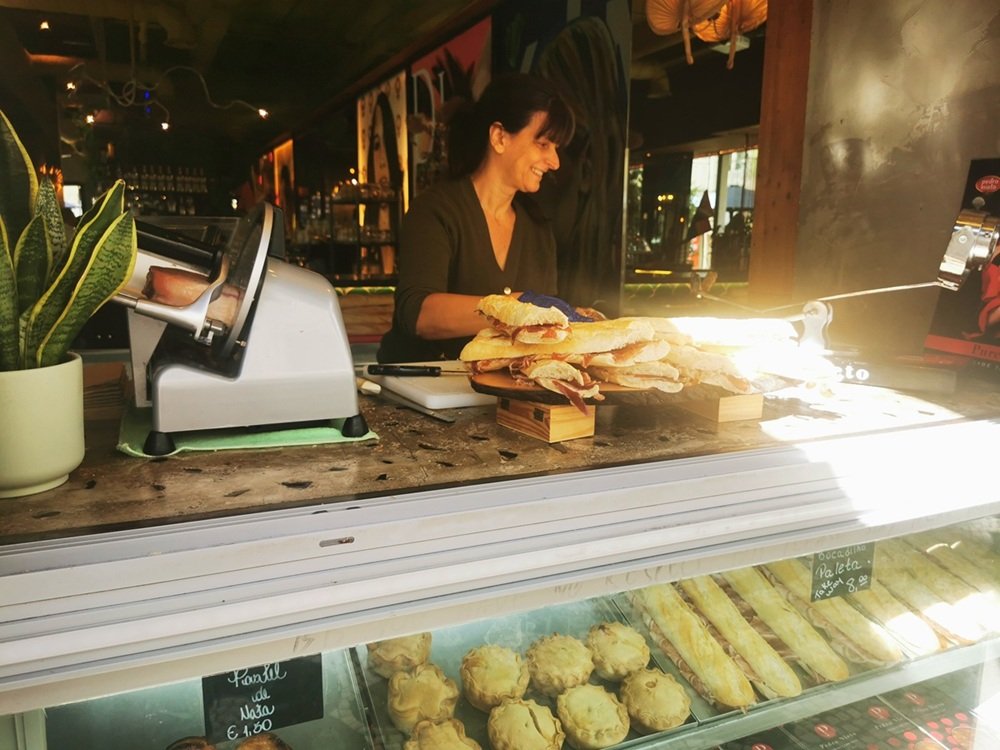
Serradura
One night in Cascais, we had finished a wonderful dinner consisting of little plates of shrimp, peppers, bread, sausage, and were relaxing with a glass of beer before asking for our check. The owner came over and insisted on giving us a dessert, asking us to guess what was in it. It was delicious, and once he explained it, unbelievably simple. This was our introduction to serradura, or sawdust pudding. Don’t be put off by the name. The sawdust refers to the biscuit crumbs. The pudding itself, the owner explained, is simply layers of condensed milk or whipped cream with crushed biscuits. Who knew that something so easy could be so wonderful!
I couldn’t come home and not have a cookbook to recreate some of the fabulous foods we had tried in Lisbon. And, as it happens, my husband had the same idea. He picked me up an English translation of a small cookbook he saw while visiting the aquarium. I later picked up a copy of Ana Patuleia Ortins’ Portuguese Home Cooking which I highly recommend. Now if only I had the crashing waves of the Atlantic and those azure blue skies to go with it!
